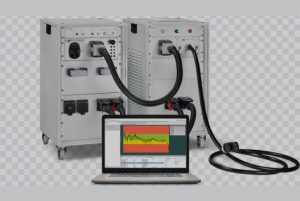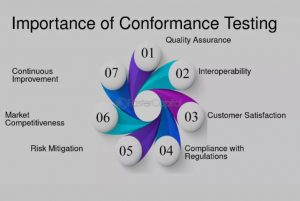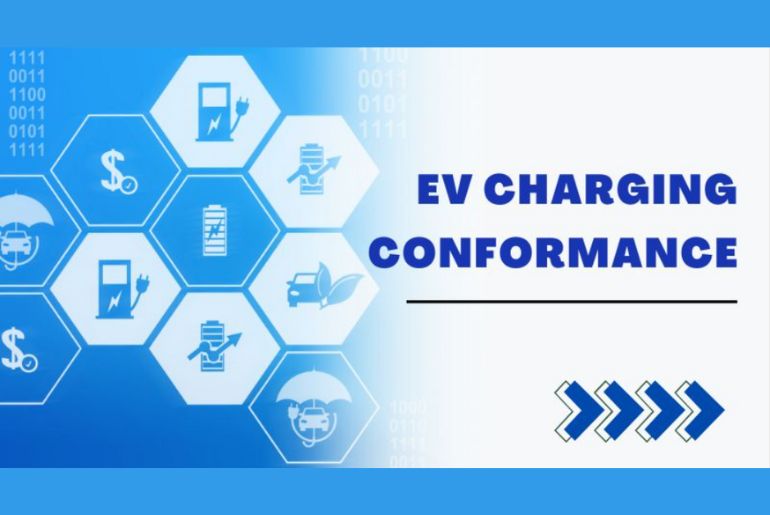As the electric vehicle (EV) market continues to grow, ensuring charging conformance has become significant for a seamless and efficient charging experience. Charging conformance refers to the adherence to standardized protocols, safety guidelines, and regulatory requirements for EV charging systems.
Key Aspects of EV Charging Conformance
 When developing and deploying electric vehicle (EV) charging infrastructure, several key considerations are crucial for success. First and foremost is safety, which ensures that charging stations are designed to protect users from electrical shocks, fire hazards, and other risks associated with high-voltage systems. Interoperability is equally important, as it allows for seamless communication between different EVs, charging stations, and networks, enabling users to charge their vehicles regardless of the provider or location. Performance plays a significant role in optimizing the charging process by focusing on speed, efficiency, and reliability, ensuring that users can quickly and conveniently power their EVs. Security is another critical aspect, as it safeguards user data, payment transactions, and the integrity of the charging infrastructure from potential cyber threats. Lastly, regulatory compliance is essential to ensure that all systems meet the necessary national and international standards, laws, and regulations, fostering trust and safety within the growing EV market. These factors collectively contribute to a robust, user-friendly, and secure charging ecosystem.
When developing and deploying electric vehicle (EV) charging infrastructure, several key considerations are crucial for success. First and foremost is safety, which ensures that charging stations are designed to protect users from electrical shocks, fire hazards, and other risks associated with high-voltage systems. Interoperability is equally important, as it allows for seamless communication between different EVs, charging stations, and networks, enabling users to charge their vehicles regardless of the provider or location. Performance plays a significant role in optimizing the charging process by focusing on speed, efficiency, and reliability, ensuring that users can quickly and conveniently power their EVs. Security is another critical aspect, as it safeguards user data, payment transactions, and the integrity of the charging infrastructure from potential cyber threats. Lastly, regulatory compliance is essential to ensure that all systems meet the necessary national and international standards, laws, and regulations, fostering trust and safety within the growing EV market. These factors collectively contribute to a robust, user-friendly, and secure charging ecosystem.
Challenges in EV Charging Conformance
One of the primary hurdles is standardization, as the lack of uniformity in charging protocols, connectors, and communication standards across different manufacturers creates confusion and limits interoperability. This inconsistency makes it difficult for EV owners to use different charging stations and can complicate the development of global charging infrastructure.
Compatibility is another challenge, as ensuring that EVs from different manufacturers are compatible with various charging stations is essential for widespread adoption. Without uniform standards, manufacturers may create proprietary systems, leading to a fragmented market that inhibits ease of use for consumers. As more companies enter the EV space, addressing compatibility becomes increasingly important for a smooth charging experience.
In addition, cybersecurity is a growing concern as EV charging infrastructure becomes more connected and reliant on digital systems. Protecting against hacking, data breaches, and other cyber threats is crucial to safeguard both user data and the integrity of the charging network. Vulnerabilities in communication systems could expose sensitive information or lead to malicious attacks on the infrastructure, highlighting the need for robust cybersecurity measures.
Scalability is another challenge that needs attention, particularly as the demand for EVs and fast charging solutions continues to grow. The infrastructure must be capable of supporting high-power charging stations and the fast-charging requirements of modern EVs. This includes the ability to handle large volumes of users, especially in urban areas, without compromising performance or reliability.
Finally, cost remains a key challenge. Ensuring that EV charging infrastructure complies with conformance standards can be expensive, and balancing these costs with the competitive nature of the market is crucial. Manufacturers and operators must find ways to minimize the financial burden of meeting these standards while ensuring the widespread availability of affordable, efficient charging solutions.
Benefits of EV Charging Conformance
EV charging conformance offers a range of significant benefits that contribute to the growth and efficiency of the electric vehicle ecosystem. First and foremost, standardization ensures a seamless and consistent user experience. When charging stations adhere to common protocols, connectors, and communication standards, EV owners can easily charge their vehicles across different locations and providers without compatibility issues. This uniformity increases consumer confidence and promotes wider adoption of electric vehicles, as users can be assured of accessibility and convenience.
Moreover, conformance enhances interoperability between different manufacturers, creating a more cohesive charging network. This is particularly important as the EV market continues to expand, with numerous companies entering the space. With established standards, vehicles and charging stations from various brands can work together, reducing fragmentation and ensuring that users are not limited to specific stations or networks.
In addition, safety is a critical benefit of charging conformance. By adhering to established standards and regulations, the risk of electrical hazards, fires, and malfunctions is minimized, making charging safer for users. This standardization also aids in regulatory compliance, helping to ensure that charging infrastructure meets national and international safety and environmental laws.
Another advantage is the boost to scalability. As the demand for EVs grows, standardized charging infrastructure can more easily scale to meet the needs of users, from basic home chargers to high-speed, public charging stations. Finally, conformance helps reduce costs by simplifying the development and maintenance of charging systems, which can lead to lower operational expenses and more affordable pricing for consumers.
Conformance Testing and Certification
 Conformance testing and certification play a crucial role in ensuring the reliability, safety, and interoperability of electric vehicle (EV) charging infrastructure. Type-approval testing verifies that both EVs and charging stations meet the necessary regulatory requirements, such as safety standards and electrical compatibility. This testing ensures that the products comply with national and international laws, giving users confidence in their safety and performance. Component testing evaluates individual parts of the charging system, such as charging cables, connectors, and plugs.
Conformance testing and certification play a crucial role in ensuring the reliability, safety, and interoperability of electric vehicle (EV) charging infrastructure. Type-approval testing verifies that both EVs and charging stations meet the necessary regulatory requirements, such as safety standards and electrical compatibility. This testing ensures that the products comply with national and international laws, giving users confidence in their safety and performance. Component testing evaluates individual parts of the charging system, such as charging cables, connectors, and plugs.
System testing assesses the integration of various components within the charging infrastructure, including the communication protocols between EVs, stations, and networks. This ensures smooth interaction and prevents issues that could arise from system incompatibilities. Certification bodies, such as UL, ETL, and CE, play a pivotal role in issuing certifications once products successfully pass these tests. These recognized certifications validate that products adhere to the highest safety and quality standards.
Finally, security conformance testing checks whether a product complies with security-related standards, ensuring the protection of sensitive data and transactions from potential cyber threats. This layer of testing is essential as the digital connectivity of EV infrastructure becomes increasingly integral to its operation, safeguarding against vulnerabilities and enhancing overall trust in the system.
Global EV Charging Conformance Initiatives
One of the most significant international standards is IEC 61851, which defines the requirements for electric vehicle conductive charging systems. This standard ensures the safety, performance, and interoperability of charging stations worldwide, laying the foundation for a consistent global charging network. Another important standard is ISO 15118, which focuses on vehicle-to-grid (V2G) communication. This standard enables seamless communication between electric vehicles and the grid, facilitating smart charging, energy sharing, and bidirectional power flow, crucial for optimizing energy distribution and supporting grid stability.
In North America, SAE J1772 is the established standard for EV charging connectors. This standard ensures that connectors are compatible with various electric vehicles, providing a safe and reliable charging experience. It is widely used in the United States and Canada, ensuring consistency and interoperability across the region. In the European Union, the Alternative Fuels Infrastructure Directive mandates the establishment of standardized charging infrastructure, aiming to create a cohesive network for alternative fuels, including electricity. This directive ensures that charging stations meet specific technical requirements, promoting uniformity across member states and supporting the growth of the EV market within Europe.
Together, these global initiatives provide a framework for the development of interoperable, efficient, and safe EV charging infrastructure, supporting the widespread adoption of electric vehicles.
Best Practices for Achieving EV Charging Conformance
One of the best practices is to collaborate with industry stakeholders, including manufacturers, regulators, and certification bodies. Working together ensures that the various components of the charging infrastructure meet common goals for safety, efficiency, and interoperability. This cooperation helps align product development with regulatory requirements and industry needs.
Another crucial practice is to adopt standardized protocols, such as those defined by IEC, ISO, and SAE. These internationally recognized standards provide a common framework for charging systems, ensuring compatibility across different manufacturers and regions. By adhering to these standards, companies can promote interoperability and streamline the adoption of EV technologies.
To stay ahead in a rapidly evolving industry, it is also essential to invest in research and development. Advancing charging technologies and improving security measures are vital for addressing emerging challenges and enhancing the overall user experience. Investing in innovation enables the development of faster, more efficient, and secure charging solutions.
Implementing robust testing and certification processes is another key practice. Rigorous testing ensures that charging equipment complies with safety, performance, and security standards, providing reliability and trust for users. Finally, it is important to monitor and update regulations regularly to keep pace with evolving industry standards. This ongoing effort ensures that charging infrastructure remains compliant with the latest technological advancements and regulatory changes, fostering long-term growth and sustainability in the EV market.
Conclusion
EV charging conformance is significant for ensuring safety, compatibility, performance, security, and regulatory compliance. Addressing challenges and adopting best practices will facilitate widespread EV adoption, contributing to a sustainable transportation future.
 Click Here to get the latest EV news and exclusive updates from EV Mechanica on WhatsApp!
Click Here to get the latest EV news and exclusive updates from EV Mechanica on WhatsApp!
 When developing and deploying electric vehicle (EV) charging infrastructure, several key considerations are crucial for success. First and foremost is safety, which ensures that charging stations are designed to protect users from electrical shocks, fire hazards, and other risks associated with high-voltage systems. Interoperability is equally important, as it allows for seamless communication between different EVs, charging stations, and networks, enabling users to charge their vehicles regardless of the provider or location. Performance plays a significant role in optimizing the charging process by focusing on speed, efficiency, and reliability, ensuring that users can quickly and conveniently power their EVs. Security is another critical aspect, as it safeguards user data, payment transactions, and the integrity of the charging infrastructure from potential cyber threats. Lastly, regulatory compliance is essential to ensure that all systems meet the necessary national and international standards, laws, and regulations, fostering trust and safety within the growing EV market. These factors collectively contribute to a robust, user-friendly, and secure charging ecosystem.
When developing and deploying electric vehicle (EV) charging infrastructure, several key considerations are crucial for success. First and foremost is safety, which ensures that charging stations are designed to protect users from electrical shocks, fire hazards, and other risks associated with high-voltage systems. Interoperability is equally important, as it allows for seamless communication between different EVs, charging stations, and networks, enabling users to charge their vehicles regardless of the provider or location. Performance plays a significant role in optimizing the charging process by focusing on speed, efficiency, and reliability, ensuring that users can quickly and conveniently power their EVs. Security is another critical aspect, as it safeguards user data, payment transactions, and the integrity of the charging infrastructure from potential cyber threats. Lastly, regulatory compliance is essential to ensure that all systems meet the necessary national and international standards, laws, and regulations, fostering trust and safety within the growing EV market. These factors collectively contribute to a robust, user-friendly, and secure charging ecosystem. Conformance testing and certification play a crucial role in ensuring the reliability, safety, and interoperability of electric vehicle (EV) charging infrastructure. Type-approval testing verifies that both EVs and charging stations meet the necessary regulatory requirements, such as safety standards and electrical compatibility. This testing ensures that the products comply with national and international laws, giving users confidence in their safety and performance. Component testing evaluates individual parts of the charging system, such as charging cables, connectors, and plugs.
Conformance testing and certification play a crucial role in ensuring the reliability, safety, and interoperability of electric vehicle (EV) charging infrastructure. Type-approval testing verifies that both EVs and charging stations meet the necessary regulatory requirements, such as safety standards and electrical compatibility. This testing ensures that the products comply with national and international laws, giving users confidence in their safety and performance. Component testing evaluates individual parts of the charging system, such as charging cables, connectors, and plugs.
